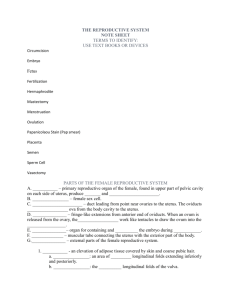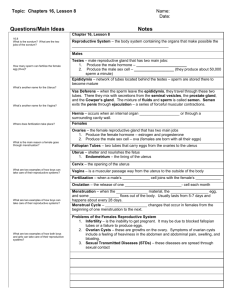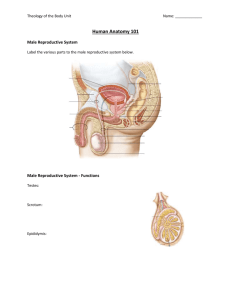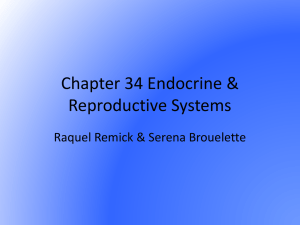Anatomy and Physiology of Reproduction
advertisement
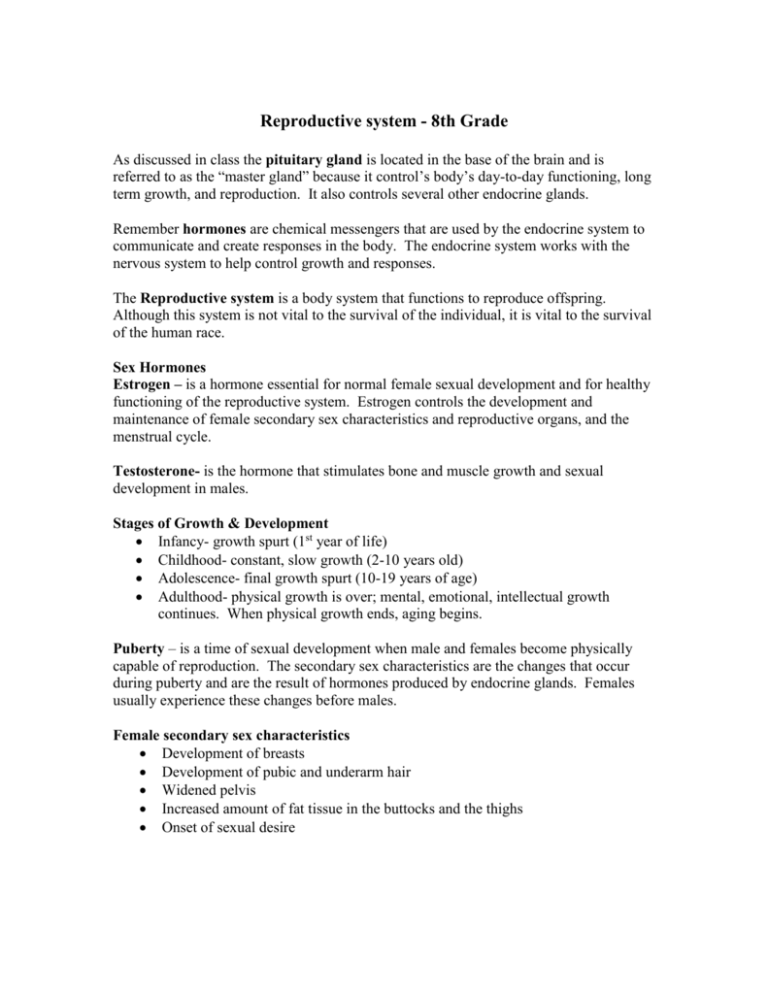
Reproductive system - 8th Grade As discussed in class the pituitary gland is located in the base of the brain and is referred to as the “master gland” because it control’s body’s day-to-day functioning, long term growth, and reproduction. It also controls several other endocrine glands. Remember hormones are chemical messengers that are used by the endocrine system to communicate and create responses in the body. The endocrine system works with the nervous system to help control growth and responses. The Reproductive system is a body system that functions to reproduce offspring. Although this system is not vital to the survival of the individual, it is vital to the survival of the human race. Sex Hormones Estrogen – is a hormone essential for normal female sexual development and for healthy functioning of the reproductive system. Estrogen controls the development and maintenance of female secondary sex characteristics and reproductive organs, and the menstrual cycle. Testosterone- is the hormone that stimulates bone and muscle growth and sexual development in males. Stages of Growth & Development Infancy- growth spurt (1st year of life) Childhood- constant, slow growth (2-10 years old) Adolescence- final growth spurt (10-19 years of age) Adulthood- physical growth is over; mental, emotional, intellectual growth continues. When physical growth ends, aging begins. Puberty – is a time of sexual development when male and females become physically capable of reproduction. The secondary sex characteristics are the changes that occur during puberty and are the result of hormones produced by endocrine glands. Females usually experience these changes before males. Female secondary sex characteristics Development of breasts Development of pubic and underarm hair Widened pelvis Increased amount of fat tissue in the buttocks and the thighs Onset of sexual desire Male secondary sex characteristics Development of facial, pubic, and underarm hair Broadened shoulders Longer and heavier bones Deepened voice Increased muscle tissue development Onset of sexual desire In addition to physical changes adolescence also includes increasing intellect, learning skills and social maturation. Sometimes changes contribute to feelings of awkwardness and they intensify concerns about appearance. Adolescents often are self-conscious and are overly concerned with what others think. Genitals are the reproductive organs. Female Reproductive System External Reproductive Organs Labia – liplike, fatty tissues that surround the opening of the vagina. The labia also cover the opening of the urethra, which is the tube that extends from the bladder to the outside of the body. Clitoris – is a small knob of erectile tissue in the front of the vaginal opening. Breasts – are not reproductive organs. They do have reproductive importance. They consist of fatty tissue and mammary gland tissue, which produce milk after the birth of a baby. Internal Reproductive Organs Ovaries- to glands that produce both hormones and ova (plural for ovum). Approximately 400 ova mature during the female’s lifetime. Fallopian tubes – (sometimes called oviducts) are two tubes that transport ova from each ovary to the uterus. Fallopian tubes do not make direct contact with the ovaries. The open end of the fallopian tubes expand to form a funnel shape. The open ends are lined with cilia, which are hairlike projections that beat and draw an ovum into the fallopian tube. The ovum moves by peristaltic contractions of the tube at the rate of one inch every twenty-four hours. Uterus – the organ that prepares each month during a female’s reproductive years to receive a fertilized ovum, to support the fertilized ovum during pregnancy and to contract during childbirth to force the delivery of the baby. The uterus is a hollow, muscular, pear shaped organ in the pelvic cavity that is located between the bladder and the rectum. Cervix – is the lowest part of the uterus. The cervix opens into the vagina. Vagina - is a muscular passageway that lies between the bladder and the rectum and serves as the female organ of intercourse, the passageway for sperm to the uterus, the birth canal, and the passageway for the menstrual flow. Menstrual cycle- is a rhythmic cycle of approximately one month in which hormone levels fluctuate to prepare a female’s body for the possibility of pregnancy. During the menstrual cycle, one ovary produces a mature ovum and the lining of the uterus is prepared to receive a fertilized egg because of the action of hormones. The first menstrual cycle is called menarche. Ovulation is the release of the mature ovum from an ovary. Ovulation generally occurs on the fourteenth day prior to the first day of the menstrual cycle. Menstruation is the process by which the lining of the uterus is expelled each month that pregnancy does not occur. Menstruation occurs each month about two weeks after ovulation and usually lasts from three to seven days. During menstruation, approximately 50 to 60 ml of blood and tissue are expelled. Cycles differ in length of time between menstruation and how long the menstrual flow lasts. Menopause is the cessation of the monthly menstrual cycle pattern. It usually occurs between the ages of forty-eight and fifty-two. Male Reproductive System The organs and structures of the male reproductive system include the scrotum, testes, seminiferous tubules, epididymis, vas deferens, seminal vesicles, ejaculatory duct, prostate gland, bulbourethral (Cowper’s) gland, urethra and penis. Scrotum – is a sac-like pouch that holds the testes and regulates the temperature of the testes. It has two compartments; each contains a testis. The testes must be 1.5 to 2 degrees cooler than the rest of the body in order to produce sperm. The scrotum contains muscles that contract in cold weather and pull the scrotum closer to the body to increase temperature. In warm weather, these muscles relax so that the testes move further away from the body to lower the temperature. Testes – are reproductive organs that secrete the male hormone testosterone and produce sperm. Testosterone is the male hormone that is responsible for male secondary sex characteristics. Seminiferous tubules – are a coiled network of tubes that fill each testis and produce sperm. Epididymis – is a comma shaped structure found on the back and upper surface of each testis where sperm are stored. Vas deferens – are two, long, thin cords that extend from the epididymis in the scrotum, and serve as a passageway for sperm. The vas deferens wind upward in the scrotum to the abdominal cavity and then turn downward to form the ejaculatory duct with the seminal vesicles. Seminal vesicles - two small glands at the end of the vas deferens that secrete a fluid that nourishes and enables the sperm to move. Ejaculatory duct – is a short straight tube that passes into the prostate gland and opens into the urethra. The Prostate gland is a gland that neutralizes acid in the male urethra and the acidic environment of the vagina. The Bulbourethral (Cowper’s) glands are two small pea shaped glands located on each side of the urethra and secrete a lubricating fluid. Urethra – is a tube like passageway that extends form the urinary bladder to the tip of the penis and the outside of the body. The urethra serves as a passageway for urine and semen. The reproductive function of the penis is to deposit sperm into the vagina during sexual intercourse. Penis- is composed of mostly erectile tissue. Erection is an involuntary process that occurs when spongy layers inside the penis are engorged with blood and cause the penis to swell and elongate. Ejaculation is the sudden expulsion of seminal fluid from an erect penis. Normally three milliliters of semen are expelled during ejaculation. Each milliliter contains about 120 million sperm. After ejaculation, the penis returns to the flaccid or nonerect state.

